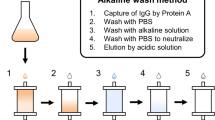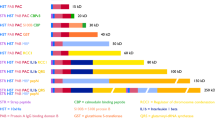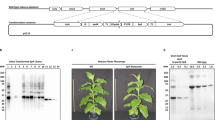Abstract
We describe a general purification method for recombinant proteins based upon the selective interaction between a poly-histidine peptide, which is fused to the protein of interest, and a novel metal chelate adsorbent. The principle of the technique is illustrated with mouse dihydrofolate reductase. DNA elements coding for adjacent histidines were fused to the mouse dihydrofolate reductase gene. Subsequent expression in E. coli resulted in the production of hybrid proteins that could be purified by immobilized metal ion affinity chromatography, followed by removal of the histidine affinity peptide with carboxypeptidase A.
This is a preview of subscription content, access via your institution
Access options
Subscribe to this journal
Receive 12 print issues and online access
$209.00 per year
only $17.42 per issue
Buy this article
- Purchase on Springer Link
- Instant access to full article PDF
Prices may be subject to local taxes which are calculated during checkout
Similar content being viewed by others
References
Moks, T., Abrahmsen, L., Oesterlöf, B., Josephson, S., Oestling, M., Enfors, S.O., Persson, I., Nilsson, B. and Uhlen, M. 1987. Large-scale affinity purification of human insulin-like growth factor I from culture medium of E. coli. Bio/Technology 5:379–382.
Germio, J. and Bastia, D. 1984. Rapid purification of a cloned gene product by genetic fusion and site specific proteolysis. Proc. Nad. Acad. Sci. USA 81:4692–4696.
Sassenfeld, H.M. and Brewer, S.J. 1984. A polypeptide fusion designed for the purification of recombinant proteins. Bio/Technology 2:76–81.
Hochuli, E., Döbeli, H. and Schacher, A. 1987. New metal chelate adsorbent selective for proteins and peptide containing neighbouring histidine residues. J. Chromatogr. 411:177–184.
Bujard, H., Gentz, R., Lanzer, M., Stüber, D., Muller, M., Ibrahimi, I., Haeuptle, M.-T., Dobberstein, B. 1987. A T5 promoter based transcription-translation system for the analysis of proteins in vivo and in vitro. Methods in Enzymology 155:416–433.
Chang, A.C.Y., Nunberg, J.H., Kaufman, R.J., Erlich, H.A., Schimke, R.T. and Cohen, S.N. 1978. Phenotypic expression in E. coli of a DNA sequence coding for mouse dihydrofolate reductase. Nature 275:617–624.
Masters, J.N., Attardi, G. 1983. The nucleotide sequence of the cDNA coding for the human dihydrofolic acid reductase. Gene 21:59–63.
Schwarz, E., Scherer, G., Hobom, G., Kässel, H. 1978. Nucleotide sequence of cro, cII and part of the 0 gene in phage lambda DNA. Nature 272:410–414.
Marcoli, R., Iida, S., Bickle, A. 1980. The DNA sequence of an IS1-flanked transposon coding for resistance to chloramphenicol and fusidic acid. FEBS Letts 110:11–14.
Brosius, J., Dull, T.J., Sleeter, D.D., Noller, H.F. 1981. Gene organization and primary structure of a ribosomal RNA operon from E. coli. J. Mol. Biol. 148:107–127.
Sutcliffe, J.G. 1979. Complete nucleotide sequence of the E. coli plasmid pBR322. Cold Spring Harbor Symp. Quant. Biol. 43:77–90.
Certa, U., Bannwarth, W., Stüber, D., Gentz, R., Lanzer, M., Le Grice, S., Guillot, F., Wendler, I., Hunsmann, G., Bujard, H. and Mous, J. 1986. Subregions of a conserve of part of the HIV gp 41 transmembrane protein are differentially recognized by antibodies of infected individuals. EMBO J. 5:3051–3056.
Gentz, R., Certa, U., Takacs, B., Matile, H., Döbeli, H., Pink, R., Mackay, M., Bone, N. and Scaife, J.G. 1988. Major surface antigen p. 190 of Plasmodium falciparum: detection of common epitopes present in a variety of plasmodia ioslates. EMBO J. 7:225–230.
Bannwarth, W., Iaiza, P. 1986. A system for the simultaneous chemical synthesis of different DNA fragments on solid support. DNA 5:413–419.
Stüber, D., Bujard, H., Hochuli, E., Kocher, H.P., Kompis, I., Talmadge, K., Weibel, E.K., Winkler, F.K., Then, R.L. 1986. Enzymatic characterization of recombinant human dihydrofolate reductase produced in E. coli, p. 839–842. Chemistry and Biology of Pteridines. Cooper, B. A., Whitehead, V. M. (Eds.). Walter de Gruyter & Co. Berlin.
Laemmli, U.K. 1970. Cleavage of structural proteins during assembly of the head of bacteriophage T4 . Nature 227:680–685.
Lowry, O.H. 1951. Protein measurement with folin phenol reagent. J. Biol. Chem. 193:265–275.
Baccanari, D.P., Averett, D., Briggs, C., Burchall, J. 1977. Escherichia coli dihydrofolate reductase: isolation and characterization of two isozymes. Biochemistry 16:3566–3572.
Author information
Authors and Affiliations
Rights and permissions
About this article
Cite this article
Hochuli, E., Bannwarth, W., Döbeli, H. et al. Genetic Approach to Facilitate Purification of Recombinant Proteins with a Novel Metal Chelate Adsorbent. Nat Biotechnol 6, 1321–1325 (1988). https://doi.org/10.1038/nbt1188-1321
Received:
Accepted:
Issue Date:
DOI: https://doi.org/10.1038/nbt1188-1321
This article is cited by
-
Cation affinity purification of histidine-tagged proteins
Applied Microbiology and Biotechnology (2023)
-
Predicting high recombinant protein producer strains of Pichia pastoris MutS using the oxygen transfer rate as an indicator of metabolic burden
Scientific Reports (2022)
-
Intracellular delivery of His-tagged proteins via a hybrid organic–inorganic nanoparticle
Polymer Journal (2021)
-
A modular two yeast species secretion system for the production and preparative application of unspecific peroxygenases
Communications Biology (2021)
-
New Bacterial Surface Display System Development and Application Based on Bacillus subtilis YuaB Biofilm Component as an Anchoring Motif
Biotechnology and Bioprocess Engineering (2021)



